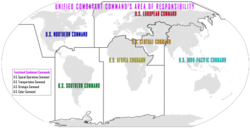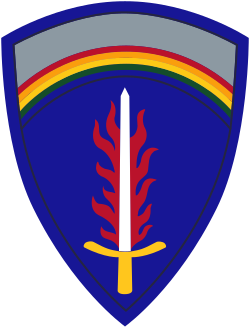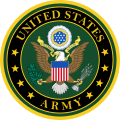| United States Africa Command | |
|---|---|
 Emblem of United States Africa Command | |
| Active | Established: 1 October 2007 (18 years, 3 months) Activated: 1 October 2008 (17 years, 3 months) [1] |
| Country | |
| Type | Unified combatant command |
| Role | Geographic combatant command |
| Size | 2,000 (1,500 stationed at HQ in Germany) [2] |
| Part of | |
| Headquarters | Kelley Barracks, Stuttgart, Germany |
| Nicknames | U.S. AFRICOM, USAFRICOM |
| Engagements | |
| Website | www.africom.mil |
| Commanders | |
| Commander | General Dagvin Anderson, USAF |
| Deputy Commander | Lieutenant General John W. Brennan, USA |
| Deputy to the Commander for Civil-Military Engagement | Ambassador Robert Scott, DOS |
| Senior Enlisted Leader | Sergeant Major Michael P. Woods, USMC |
| Insignia | |
| NATO Map Symbol [3] |  |
The United States Africa Command (USAFRICOM, U.S. AFRICOM, and AFRICOM) [4] is one of the eleven unified combatant commands of the United States Department of Defense, headquartered at Kelley Barracks in Stuttgart, Germany. It is responsible for U.S. military operations, including fighting regional conflicts [5] and maintaining military relations with 53 African nations. [6] Its area of responsibility covers all of Africa except Egypt, which is within the area of responsibility of the United States Central Command. U.S. AFRICOM headquarters operating budget was $276 million in fiscal year 2012. [2]
Contents
- History
- Origins
- Creation of the command (2006–2008)
- Function
- Area of responsibility
- Headquarters and facilities
- Selection of the headquarters
- Personnel
- Components
- U.S. Army Europe and Africa (USAREUR-AF)
- U.S. Naval Forces Africa (NAVAF)
- Air Forces Africa (AFAFRICA)
- U.S. Marine Corps Forces, Africa (MARFORAF)
- Subordinate commands
- Combined Joint Task Force – Horn of Africa
- Programs and operations
- By country
- Programs
- Joint Exercise Programs
- List of commanders
- References
- Further reading
- External links
| United States Armed Forces |
|---|
 |
| Executive departments |
| Staff |
| Military departments |
| Military services |
| Command structure |
The Commander of U.S. AFRICOM reports to the secretary of defense. [7] The current Commander of the U.S. Africa Command stated that the purpose of the command is to work alongside African military personnel to support their military operations. [8] In individual countries, U.S. ambassadors continue to be the primary diplomatic representative for relations with host nations. The incumbent commander is Dagvin Anderson.


















